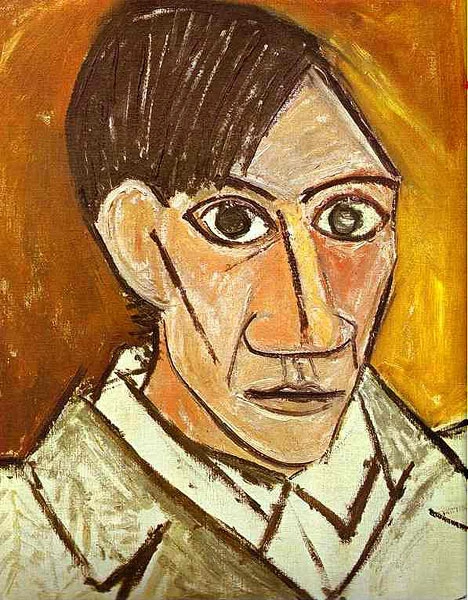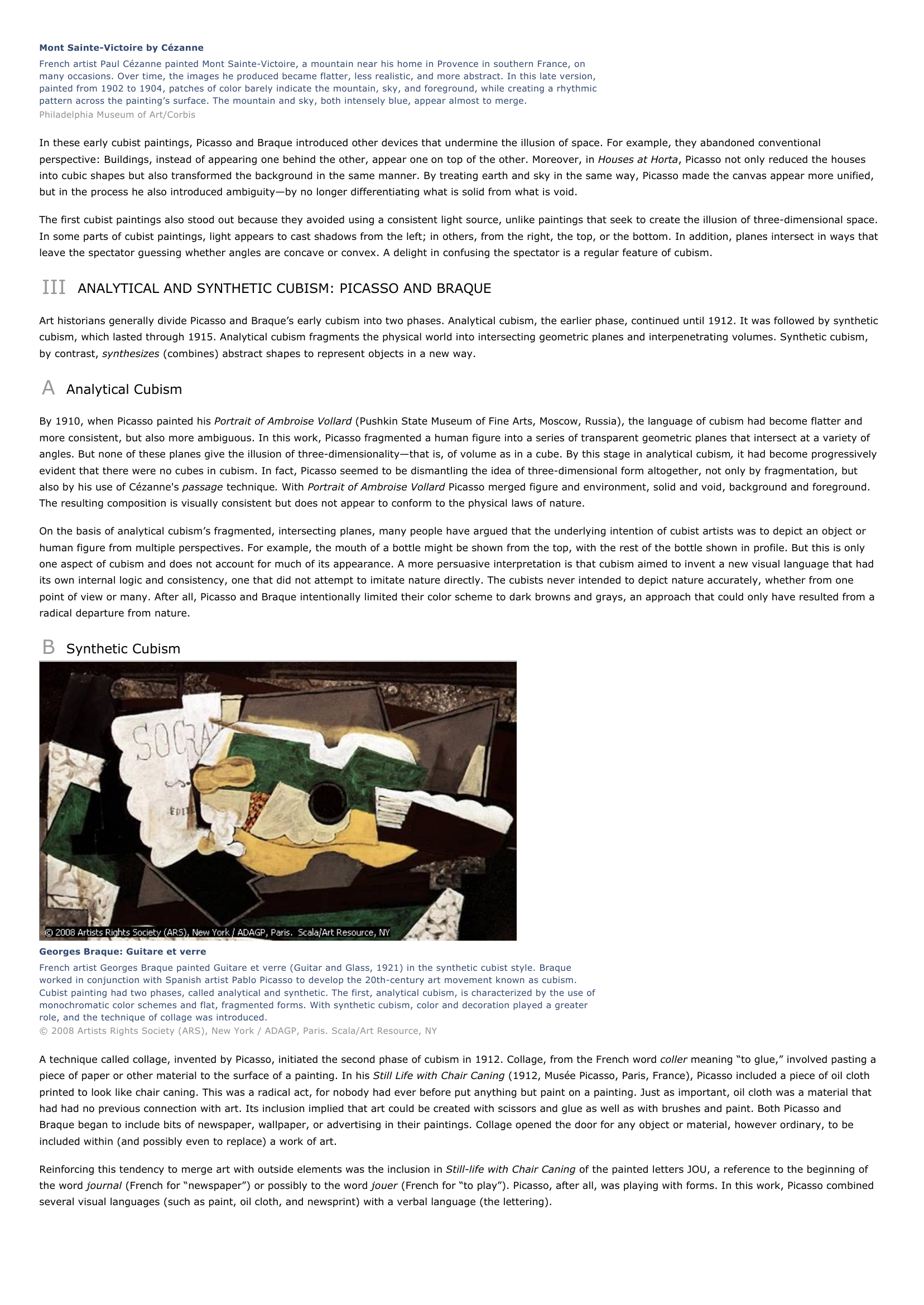Cubism I INTRODUCTION Cubism, movement in modern art, especially in painting, invented by Spanish artist Pablo Picasso and French artist Georges Braque in 1907 and 1908.
Publié le 12/05/2013

Extrait du document


«
Mont Sainte-Victoire by CézanneFrench artist Paul Cézanne painted Mont Sainte-Victoire, a mountain near his home in Provence in southern France, onmany occasions.
Over time, the images he produced became flatter, less realistic, and more abstract.
In this late version,painted from 1902 to 1904, patches of color barely indicate the mountain, sky, and foreground, while creating a rhythmicpattern across the painting’s surface.
The mountain and sky, both intensely blue, appear almost to merge.Philadelphia Museum of Art/Corbis
In these early cubist paintings, Picasso and Braque introduced other devices that undermine the illusion of space.
For example, they abandoned conventionalperspective: Buildings, instead of appearing one behind the other, appear one on top of the other.
Moreover, in Houses at Horta , Picasso not only reduced the houses into cubic shapes but also transformed the background in the same manner.
By treating earth and sky in the same way, Picasso made the canvas appear more unified,but in the process he also introduced ambiguity—by no longer differentiating what is solid from what is void.
The first cubist paintings also stood out because they avoided using a consistent light source, unlike paintings that seek to create the illusion of three-dimensional space.In some parts of cubist paintings, light appears to cast shadows from the left; in others, from the right, the top, or the bottom.
In addition, planes intersect in ways thatleave the spectator guessing whether angles are concave or convex.
A delight in confusing the spectator is a regular feature of cubism.
III ANALYTICAL AND SYNTHETIC CUBISM: PICASSO AND BRAQUE
Art historians generally divide Picasso and Braque’s early cubism into two phases.
Analytical cubism, the earlier phase, continued until 1912.
It was followed by syntheticcubism, which lasted through 1915.
Analytical cubism fragments the physical world into intersecting geometric planes and interpenetrating volumes.
Synthetic cubism,by contrast, synthesizes (combines) abstract shapes to represent objects in a new way.
A Analytical Cubism
By 1910, when Picasso painted his Portrait of Ambroise Vollard (Pushkin State Museum of Fine Arts, Moscow, Russia), the language of cubism had become flatter and more consistent, but also more ambiguous.
In this work, Picasso fragmented a human figure into a series of transparent geometric planes that intersect at a variety ofangles.
But none of these planes give the illusion of three-dimensionality—that is, of volume as in a cube.
By this stage in analytical cubism , it had become progressively evident that there were no cubes in cubism.
In fact, Picasso seemed to be dismantling the idea of three-dimensional form altogether, not only by fragmentation, butalso by his use of Cézanne's passage technique .
With Portrait of Ambroise Vollard Picasso merged figure and environment, solid and void, background and foreground. The resulting composition is visually consistent but does not appear to conform to the physical laws of nature.
On the basis of analytical cubism’s fragmented, intersecting planes, many people have argued that the underlying intention of cubist artists was to depict an object orhuman figure from multiple perspectives.
For example, the mouth of a bottle might be shown from the top, with the rest of the bottle shown in profile.
But this is onlyone aspect of cubism and does not account for much of its appearance.
A more persuasive interpretation is that cubism aimed to invent a new visual language that hadits own internal logic and consistency, one that did not attempt to imitate nature directly.
The cubists never intended to depict nature accurately, whether from onepoint of view or many.
After all, Picasso and Braque intentionally limited their color scheme to dark browns and grays, an approach that could only have resulted from aradical departure from nature.
B Synthetic Cubism
Georges Braque: Guitare et verreFrench artist Georges Braque painted Guitare et verre (Guitar and Glass, 1921) in the synthetic cubist style.
Braqueworked in conjunction with Spanish artist Pablo Picasso to develop the 20th-century art movement known as cubism.Cubist painting had two phases, called analytical and synthetic.
The first, analytical cubism, is characterized by the use ofmonochromatic color schemes and flat, fragmented forms.
With synthetic cubism, color and decoration played a greaterrole, and the technique of collage was introduced.© 2008 Artists Rights Society (ARS), New York / ADAGP, Paris.
Scala/Art Resource, NY
A technique called collage, invented by Picasso, initiated the second phase of cubism in 1912.
Collage, from the French word coller meaning “to glue,” involved pasting a piece of paper or other material to the surface of a painting.
In his Still Life with Chair Caning (1912, Musée Picasso, Paris, France), Picasso included a piece of oil cloth printed to look like chair caning.
This was a radical act, for nobody had ever before put anything but paint on a painting.
Just as important, oil cloth was a material thathad had no previous connection with art.
Its inclusion implied that art could be created with scissors and glue as well as with brushes and paint.
Both Picasso andBraque began to include bits of newspaper, wallpaper, or advertising in their paintings.
Collage opened the door for any object or material, however ordinary, to beincluded within (and possibly even to replace) a work of art.
Reinforcing this tendency to merge art with outside elements was the inclusion in Still-life with Chair Caning of the painted letters JOU, a reference to the beginning of the word journal (French for “newspaper”) or possibly to the word jouer (French for “to play”).
Picasso, after all, was playing with forms.
In this work, Picasso combined several visual languages (such as paint, oil cloth, and newsprint) with a verbal language (the lettering)..
»
↓↓↓ APERÇU DU DOCUMENT ↓↓↓
Liens utiles
- Expressionism I INTRODUCTION Auguste Rodin Regarded as the foremost sculptor of the 19th and 20th centuries, French artist Auguste Rodin captured both dynamic movement and inner psychological states.
- Poseidon Greek Sea god and one of the Olympian gods; son of Cronus and Rhea; brother of Zeus, Hades, Demeter, Hera, and Hestia; husband The Roman goddess Pomona displays her fruits of plenty in the painting by French artist Nicholas Fouche (1653-1733).
- Édouard Manet I INTRODUCTION Manet: Tradition and Innovation French impressionist painter Édouard Manet shocked art audiences in Paris with Le déjeuner sur l'herbe (The Luncheon on the Grass; 1863, Musée d'Orsay, Paris), which depicts a nude woman at a woodland picnic.
- Francisco José de Goya y LucientesIINTRODUCTIONFrancisco de GoyaOne of the great masters of Spanish art, painter and illustrator Francisco José de Goya y Lucientes produced works ofconsiderable beauty and power.
- Diego Velázquez (artist) I INTRODUCTION Velázquez and Baroque Theatricality Spanish painter Diego Velázquez presents two scenes in The Fable of Arachne (about 1656, Museo del Prado, Madrid, Spain), also known as The Spinners.








